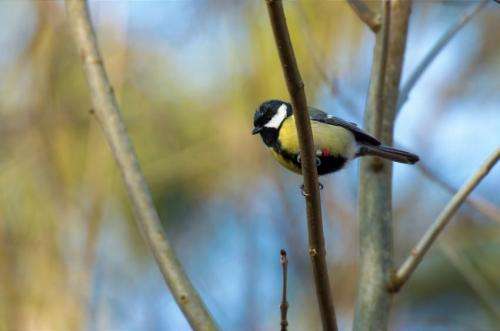Risk-taking behavior depends on metabolic rate and temperature in great tits

Animals often differ in their behavioural response to risky situations such as exposure to predators. Researchers from the Max Planck Institute for Ornithology now found in a long-term study on different populations of great tits that risk-taking behaviour correlates with both metabolic rate and ambient temperature. High metabolic rates and low temperatures were associated with high risk-taking behaviour, as in these scenarios birds were more likely to approach potential predators.
The readiness to take a risk is to a great extent influenced by external circumstances. A recent study showed that men living singly are more risk-prone than those living in a steady relationship. Individual differences in risk-taking behaviour are present not only in humans but also in other vertebrates and even in invertebrates such as the Beadlet anemone. However, not only external factors can explain these differences in behaviour, but also the basal metabolic rate of the body. For example, in great tits there are large individual differences in basal metabolic rate are consistent over extended periods of time (e.g. years).
A team of researchers from the Max Planck Institute for Ornithology in Seewiesen now found in a long-term study in great tits a relationship between risk-taking behaviour and metabolic rate. Moreover, they investigated how risk-taking behaviour depends on environmental factors. Within the study period of two years they were able to determine the behaviour and metabolic rate of 184 individual great tits from 12 populations between two lakes in Upper Bavaria, the "Ammersee" and the "Starnberger See". The birds were captured when roosting inside their nest boxes and brought to the lab to measure metabolic rates. The birds were then equipped with passive transponders, so-called "pit-tags", and released back to their territories. There, the researchers installed bird feeders that were fitted with antennas connected to radio frequency identification readers to monitor the movement of great tits. In order to monitor risk-taking behaviour a stuffed model of a sparrowhawk was presented next to the feeders accompanied by playbacks of great tit mobbing calls. With the aid of the transponders, the researchers were able to measure the time that the birds needed to return to the feeder after the disturbance. This measure was then used as a measure for risk-taking behaviour for further analysis.
As a next step the researchers investigated how all these factors were related to each other by means of complex statistical analyses. They first found that the great tits differed in metabolic rate, body mass, and risk-taking behaviour between both study years; in the year when birds had higher metabolic rate, they also showed higher levels of risk-taking behaviour. Additionally, within each year, birds with higher metabolic rates returned to the feeder sooner after being presented with the predator disturbance. Amazingly, ambient temperature also had an influence on overall risk-taking behaviour; birds tended to take more risks when temperatures were lower "This study shows that variation in risk-taking behaviour is linked to differences in energy constraints. Birds facing higher energetic constraints - either because they have a higher metabolic rate or because low ambient temperatures cause them to spend more energy on thermoregulation – are more willing to forage under "risky" conditions, like when a predator has recently been observed in the area," concludes Kimberley Mathot, first author of the study. Possibly birds with a high metabolic rate simply cannot afford to delay feeding because of their higher energetic needs, and thus are more willing to take risks.
More information: Kimberley J. Mathot, Marion Nicolaus, Yimen G. Araya-Ajoy, Niels J.Dingemanse, Bart Kempenaers, Does metabolic rate predict risk-taking behaviour? A field experiment in a wild passerine bird, Functional Ecology, 29 September 2014
Journal information: Functional Ecology
Provided by Max Planck Society





















